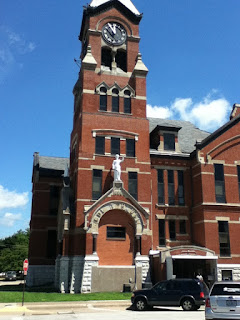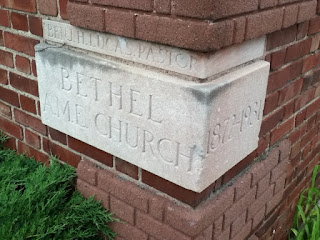 |
| Where the Highway Trust Fund is headed; from US Dept of Transportation website |
The Department of Transportation, in its single-minded pursuit of traffic flow, has destroyed more American towns than General Sherman.--ANDRES DUANY (quoted at Speck 2012: 87)
The U.S. Highway Trust Fund runs out of money at the end this week, unless Congress can agree on an appropriations formula. The fact that both the House and Senate are seriously at work suggests they're close, but details (including non-germane provisions attached to this supposedly "must-pass" measure) remain to be negotiated. Note that "pay-as-you-go" budget rules require that Congress offset increased spending in this area with compensating revenue or savings somewhere else. The Senate is poised to vote on a six-year extension of the fund, plus reauthorization of the Export-Import Bank, albeit the bill only accounts for funding for the first three years through a number of fixes; the House has passed a short-term extension, after which they hope to have funding for a long-term extension from reform of the way the government treats overseas corporate income (Mejdrich, Mascaro, Weisman).
Congress could choose instead to continue with the sort of short-term, stop-gap approach that has governed transportation funding since the last federal act expired in 2010. Alternatively there always remains the possibility that no deal will be done and the federal government will withdraw from transportation funding altogether. So which outcome should I root for?
My reptile brain wants to see no deal, not only because it would be interesting, but because it would force policy makers, businesses and citizens to examine the easy assumptions we've been collectively making (see Chuck Marohn's extended commentary from one year ago, cited below). Locally I see an expensive highway extension and an irrational city bus system, both made possible by federal dollars, and there's no need for us to question them because they're, like, "free." But my inner mammal wants to know if there is more to the story. The U.S. Department of Transportation (cited below) reports that the deferral of maintenance means 65 percent of America's roads are in "less than good condition," and 25 percent of bridges can't handle the necessary because of either disrepair or obsolescence, and they have the state-by-state numbers to show it. This degree of disrepair a problem, even if you quibble with their numbers. Is a rejuvenated Highway Trust Fund the solution?
Some background: The national government has been funding highways since the Federal Aid Road Act of 1916, with the notable development of limited access highways beginning with the Federal Highway Act of 1956. Mass transit aid began in 1974. These efforts are funded in part by a federal excise tax on gasoline, currently 18.4 cents per gallon--currently 15.5 cents go to roads, 2.86 cents to transit--but the revenues don't come close to covering maintenance of the existing network and new construction. States also tax gasoline to fund highways--and in some cases transit--but their funds also face shortfalls.
Roads have long been considered a government function because of (1) their positive externalities--good transportation contributes to the movement of goods as well as things like public health--and because (2) the short-term return on investment is way too small for a private firm to undertake (see Smith, Wealth of Nations, Book V). The federal government became involved on the same logic: intercity transportation helped the national economy enough that the US writ large couldn't wait on the incentives or capacities of individual states like, say, South Dakota (ideal for trucking but low tax base). Also, (3) the federal government is better--not super-great, but better--than either state governments or the market at incorporating long-term considerations and negative externalities into its policies.
Unfortunately, the political process has profound difficulty incorporating price signals into its thinking. How we decide to spend transportation dollars depends on the interplay of political ideology, the power of interest groups and politicians, no-think formulae, wishful thinking and incrementalism more than it does on public opinion--which isn't always well-informed anyhow--or rational calculation of costs, benefits and return on investment. (See Grunwald on the particularly egregious example of Wisconsin.) So the federal government somehow got into intracity highways, flattening older working-class neighborhoods in the process (Ye et al., Grunwald, Carsner ch 4); mass transit funding, however well-motivated, has been spread foolishly (King); and infrastructure maintenance has been neglected in favor of funding new construction (Grunwald, Jaffe). Budget considerations can force governments to make hard choices, but the farther removed the decision process--for example, federal funding of local transportation projects--the more attenuated the budgetary impact on decision making.
I'm also disconcerted by some of the poorer arguments in favor of continued funding. Bad rationales don't necessarily lead to bad implementation, but let's be very afraid anyway. A number of backers, mostly but not exclusively Democrats, point to the Highway Trust Fund's impact on job creation. This is not in itself a good justification for what would amount to public works spending. There arguably is a time and place for economic stimulus through public works, but that would not be now, when the economy is growing. Instead we should look for opportunities to sustain that growth. Building highways is not it.
The American Automobile Association, I am chagrined to say, argues for new highway construction as a way to relieve congestion (Kelly and O'Donnell). I am chagrined to say this because I am a member of AAA. Happily their roadside assistance is more effective than their policy analysis. (See Jeff Speck, Walkable City [Farrar Straus Giroux, 2012], 80-94, for a readable summary of studies on "induced demand," wherein highway-building leads to more traffic resulting in the same or worse level of congestion. This is counter-intuitive but pretty well-established.) On the other hand, mass transit, done right, has served to reduce congestion (Farrell 11-13).
Absent federal funding, would Cedar Rapids and other similar communities have chosen to induce sprawl by massive highway construction? But, absent federal funding, would mass transit and intercity rail have the faintest prayer of competing for resources with streets and highways?
UPDATE 8/3/15: The House and Senate passed a three-month funding extension last week, that would last through the end of October 2015.
SOURCE MATERIAL
- Darcie Carsner, Ethnicity in Political Participation: The Case of Czech Village, Coe College, 1996
- Christopher E. Farrell, "The Benefits of Transit in the United States," Mineta Transportation Institute (July 2015), http://transweb.sjsu.edu/PDFs/research/1425-US-transit-benefit-cost-analysis-study.pdf
- Michael Grunwald, "Overpasses: A Love Story," Politico, August 2015, http://www.politico.com/agenda/story/2015/07/transportation-infrastructure-scott-walker-highways-000153
- Eric Jaffe, "America's Infrastructure Crisis is Really a Maintenance Crisis," City Lab, 12 February 2015, http://www.citylab.com/cityfixer/2015/02/americas-infrastructure-crisis-is-really-a-maintenance-crisis/385452/
- Erin Kelly and Jayne O'Donnell, "Senators Defeat Obamacare Repeal; Lawmakers Meet to Renew Highway Fund," USA Today, 27 July 2015, 3A
- David A. King, "A Different Way to Evaluate New Transport Investment Subsidy," Transportationist, 4 November 2014, http://transportationist.org/2014/11/04/a-different-way-to-evaluate-new-transport-investment-subsidy/
- Charles Marohn, "Some Perspective on the Gas Tax," Strong Towns, 24 July 2014, http://www.strongtowns.org/journal/2014/7/24/some-perspective-on-the-gas-tax.html#.U9ncUvmwLcA
- Lisa Mascaro, "Impasse Endangers Highway Funds," Los Angeles Times, 27 July 2015, A5
- Kellie Mejdrich, "Endless Roadblocks," CQ Weekly, 27 July 2015, 27-28
- U.S. Department of Transportation, "We Must Invest in America's Transportation Future," 9 July 2015, http://www.transportation.gov/policy-initiatives/grow-america/we-must-invest-americas-transportation-future
- Jonathan Weisman, "House Plan for Highway Bill Has Skeptics in the Senate," New York Times, 17 July 2015, A1
- Alice Ye, Sam Brandt, Samantha Brown and Begum Cital, "How the Dan Ryan Changed the South Side," Curious City, 4 June 2013, http://www.wbez.org/series/curious-city/how-dan-ryan-changed-south-side-107536
























































